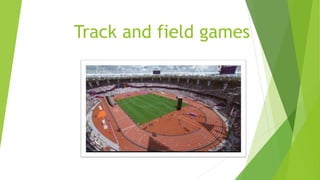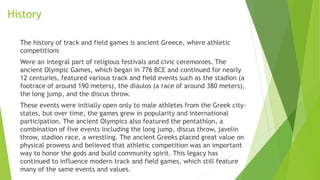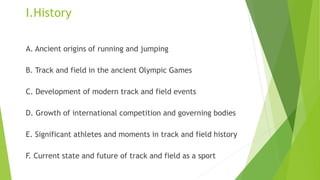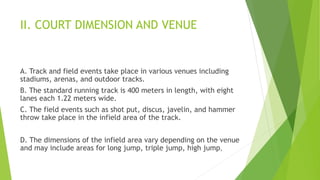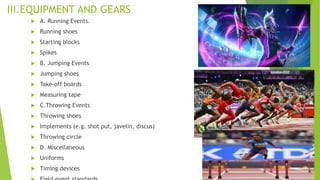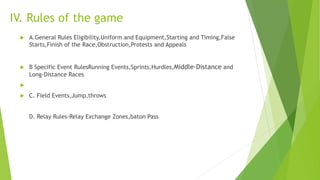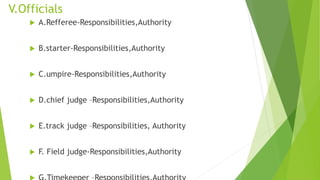Presentation (3).pptx
- 1. Track and field games
- 2. History The history of track and field games is ancient Greece, where athletic competitions Were an integral part of religious festivals and civic ceremonies. The ancient Olympic Games, which began in 776 BCE and continued for nearly 12 centuries, featured various track and field events such as the stadion (a footrace of around 190 meters), the diaulos (a race of around 380 meters), the long jump, and the discus throw. These events were initially open only to male athletes from the Greek city- states, but over time, the games grew in popularity and international participation. The ancient Olympics also featured the pentathlon, a combination of five events including the long jump, discus throw, javelin throw, stadion race, a wrestling. The ancient Greeks placed great value on physical prowess and believed that athletic competition was an important way to honor the gods and build community spirit. This legacy has continued to influence modern track and field games, which still feature many of the same events and values.
- 3. I.History A. Ancient origins of running and jumping B. Track and field in the ancient Olympic Games C. Development of modern track and field events D. Growth of international competition and governing bodies E. Significant athletes and moments in track and field history F. Current state and future of track and field as a sport
- 4. II. COURT DIMENSION AND VENUE A. Track and field events take place in various venues including stadiums, arenas, and outdoor tracks. B. The standard running track is 400 meters in length, with eight lanes each 1.22 meters wide. C. The field events such as shot put, discus, javelin, and hammer throw take place in the infield area of the track. D. The dimensions of the infield area vary depending on the venue and may include areas for long jump, triple jump, high jump,
- 5. III.EQUIPMENT AND GEARS ’üĄ A. Running Events. ’üĄ Running shoes ’üĄ Starting blocks ’üĄ Spikes ’üĄ B. Jumping Events ’üĄ Jumping shoes ’üĄ Take-off boards ’üĄ Measuring tape ’üĄ C.Throwing Events ’üĄ Throwing shoes ’üĄ Implements (e.g. shot put, javelin, discus) ’üĄ Throwing circle ’üĄ D. Miscellaneous ’üĄ Uniforms ’üĄ Timing devices
- 6. IV. Rules of the game ’üĄ A.General Rules Eligibility,Uniform and Equipment,Starting and Timing,False Starts,Finish of the Race,Obstruction,Protests and Appeals ’üĄ B Specific Event RulesRunning Events,Sprints,Hurdles,Middle-Distance and Long-Distance Races ’üĄ ’üĄ C. Field Events,Jump,throws D. Relay Rules-Relay Exchange Zones,baton Pass
- 7. V.Officials ’üĄ A.Refferee-Responsibilities,Authority ’üĄ B.starter-Responsibilities,Authority ’üĄ C.umpire-Responsibilities,Authority ’üĄ D.chief judge ŌĆōResponsibilities,Authority ’üĄ E.track judge ŌĆōResponsibilities, Authority ’üĄ F. Field judge-Responsibilities,Authority
